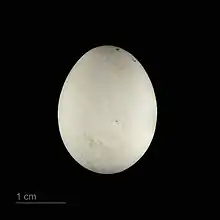| Goldie's lorikeet | |
|---|---|
 | |
| At Newport Aquarium, Kentucky, USA. | |
| Scientific classification | |
| Domain: | Eukaryota |
| Kingdom: | Animalia |
| Phylum: | Chordata |
| Class: | Aves |
| Order: | Psittaciformes |
| Family: | Psittaculidae |
| Tribe: | Loriini |
| Genus: | Glossoptilus Hartert, 1896 |
| Species: | G. goldiei |
| Binomial name | |
| Glossoptilus goldiei (Sharpe, 1882) | |

Goldie's lorikeet (Glossoptilus goldiei) is a species of parrot in the family Psittaculidae. It is the only species placed in the genus Glossoptilus. It is found in forest and woodland in New Guinea, primarily at altitudes of 1000–2200 m. It is mostly green with yellowish streaks in the chest area, and a red, blue and purple head. It is a small bird measuring 19 cm (7 ½ in) in length and weighing 45–60 grams.[2]
Taxonomy
Goldie's lorikeet was formally described in 1882 by the English ornithologist Richard Bowdler Sharpe from a specimen collected in New Guinea by Andrew Goldie (1840–1891). Sharpe coined the binomial name Trichoglossus goldiei.[3] Goldie's lorikeet was formerly placed in the genus Psitteuteles but was moved to its own genus Glossoptilus following the publication in 2020 of a phylogenetic study of the lorikeets.[4][5][6] The genus Glossoptilus had been introduced in 1896 by Walter Rothschild and Ernst Hartert.[7]
Description
Goldie's lorikeet is 19 cm (7.5 in) long. It is mainly green, and its underside is yellow-green with dark green longitudinal streaks. It has a red plumage on the crown, which is less extensive in the female. The back of its head is blue, its cheeks are mainly mauve and blue, its beak is black, and its irises are brown. Its legs are greenish-brown. In juveniles the red on the head is reduced to a small red patch above its beak. Juveniles have a brown beak, a green crown, and greyish-blue plumage on the back of the head.[8]
Range
Goldie's lorikeet is native to the highlands of New Guinea.[1]
Aviculture
Goldie's lorikeet is well regarded as a pet. They are quiet, non-destructive, non-aggressive, and can be kept as a single pair or in larger communities. Some lorikeets have learned to mimic human voices.[9]
References
- 1 2 BirdLife International (2012). "Psitteuteles goldiei". IUCN Red List of Threatened Species. 2012. Retrieved 26 November 2013.
- ↑ Collar, N.J. (1997). Family Psittacidae (Parrots). pp. 280–477 in: del Hoyo, J., Elliot, A. & Sargatal, J. eds. (1997). Handbook of the Birds of the World. Vol 4. Sandgrouse to Cuckoos. Lynx Edicions: Barcelona
- ↑ Sharpe, R. Bowdler (1882). "Contributions to the ornithology of New Guinea". Journal of the Linnean Society of London. Zoology. 16: 317–319 [317]. doi:10.1111/j.1096-3642.1882.tb02284.x.
- ↑ Smith, B.T.; Mauck, W.M.I.; Benz, B.W.; Andersen, M.J. (2020). "Uneven missing data skew phylogenomic relationships within the lories and lorikeets". Genome Biology and Evolution. 12 (7): 1131–1147. doi:10.1093/gbe/evaa113. PMC 7486955. PMID 32470111.
- ↑ Joseph, L.; Merwin, J.; Smith, B.T. (2020). "Improved systematics of lorikeets reflects their evolutionary history and frames conservation priorities". Emu – Austral Ornithology. 120 (3): 201–215. doi:10.1080/01584197.2020.1779596. S2CID 222094508.
- ↑ Gill, Frank; Donsker, David; Rasmussen, Pamela, eds. (July 2021). "Parrots, cockatoos". IOC World Bird List Version 11.2. International Ornithologists' Union. Retrieved 22 July 2021.
- ↑ Rothschild, Walter; Hartert, Ernst (1896). "Contributions to the ornithology of the Papuan Islands". Novitates Zoologicae. 3: 530–536 [532].
- ↑ Forshaw (2006). plate 14.
- ↑ "Goldie's lorikeet profile". loriinae.com. 2 December 2007. Archived from the original on 22 October 2007. Retrieved 2 December 2007.
Cited texts
- Forshaw, Joseph M. (2006). Parrots of the World; an Identification Guide. Illustrated by Frank Knight. Princeton University Press. ISBN 0-691-09251-6.
